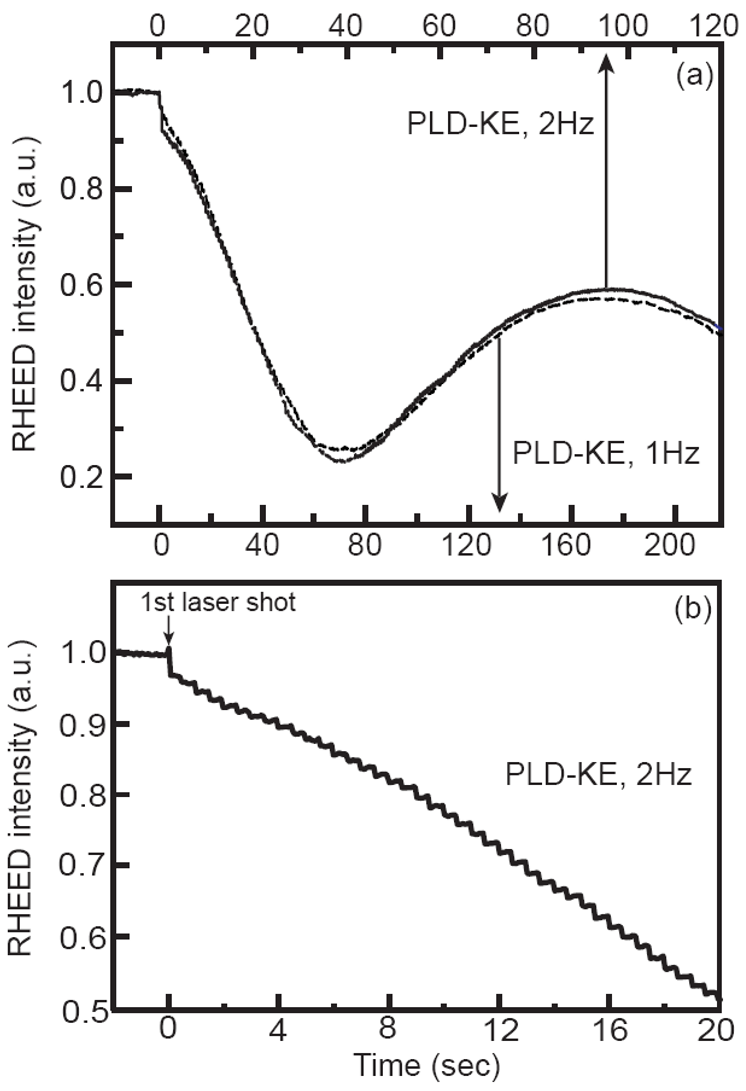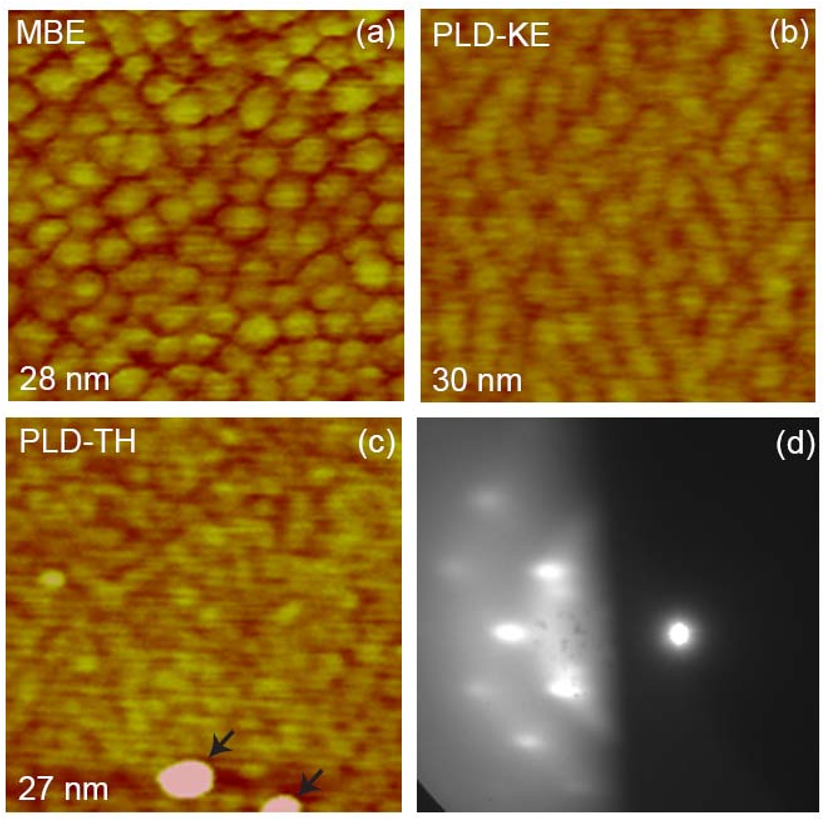Kinetic-energy induced smoothening and delay of epitaxial breakdown in pulsed-laser deposition
Byungha Shin,Michael J. Aziz +1 more
TLDR
In this paper, the effect of kinetic energy of depositing species from flux pulsing during pulsed-laser deposition (PLD) on surface morphology evolution of Ge(001) homoepitaxy at low temperature was isolated.Abstract:
We have isolated the effect of kinetic energy of depositing species from the effect of flux pulsing during pulsed-laser deposition (PLD) on surface morphology evolution of Ge(001) homoepitaxy at low temperature $(100\phantom{\rule{0.2em}{0ex}}\ifmmode^\circ\else\textdegree\fi{}\mathrm{C})$. Using a dual molecular beam epitaxy (MBE) PLD chamber, we compare morphology evolution from three different growth methods under identical experimental conditions except for the differing nature of the depositing flux: (a) PLD with average kinetic energy $300\phantom{\rule{0.3em}{0ex}}\mathrm{eV}$ (PLD-KE); (b) PLD with suppressed kinetic energy comparable to thermal evaporation energy (PLD-TH); and (c) MBE. The thicknesses at which epitaxial breakdown occurs are ranked in the order $\mathrm{PLD}\text{\ensuremath{-}}\mathrm{KE}g\mathrm{MBE}g\mathrm{PLD}\text{\ensuremath{-}}\mathrm{TH}$; additionally, the surface is smoother in PLD-KE than in MBE. The surface roughness of the films grown by PLD-TH cannot be compared due to the early epitaxial breakdown. These results demonstrate convincingly that kinetic energy is more important than flux pulsing in the enhancement of epitaxial growth, i.e., the reduction in roughness and the delay of epitaxial breakdown.read more
Figures

Fig. 4. (a) RHEED specular intensity variations during PLD-KE with 1 Hz (dashed line) and 2 Hz (solid line) of repetition rate while keeping instantaneous flux the same in both cases. Time axes are adjusted such that intensity minima and maxima for both cases are aligned at the same positions on abscissa. (b) First 20 seconds of RHEED intensity variation of PLD-KE with 1 Hz from (a). Modulations from individual laser pulses are visible. 
Fig. 2. (Color online) AFM images of films grown at 100 °C by (a) MBE, (b) PLD-KE, and (c) PLD-TH, and (d) RHEED pattern taken from surface shown in (c). Scan size and vertical scale of (a) – (c) are 0.25 x 0.25 μm2 and 5 nm, respectively. Thickness of films in (a) – (c) is shown in the left bottom corner of each image. 
Table I. Epitaxial thickness of PLD-KE, PLD-TH, and MBE at 100 °C and 150 °C. In the case of PLD-KE, the thickest samples – 270 nm at 100 °C and 410 nm at 150 °C – are still fully epitaxial.
Citations
More filters
Journal ArticleDOI
Recent advances in pulsed-laser deposition of complex oxides
Hans M. Christen,Gyula Eres +1 more
TL;DR: Detailed growth kinetics results are discussed, which illustrate that 'true' layer-by-layer (LBL) growth can only be approached, not fully met, even though many characterization techniques reveal interfaces with unexpected sharpness.
Journal ArticleDOI
Film Growth Mechanisms in Pulsed Laser Deposition
TL;DR: In this article, a comparison of growth morphology evolution for pulsed laser deposition and thermal deposition in the same dual-use chamber under identical thermal, background, and surface preparation conditions, and varying the kinetic energy by varying the laser fluence or using an inert background gas was made.
Journal ArticleDOI
Impact of the interplay between nonstoichiometry and kinetic energy of the plume species on the growth mode of SrTiO 3 thin films
TL;DR: In this paper, the authors studied the pulsed laser deposition of homoepitaxial SrTiO3 thin films in different deposition regimes in order to elucidate the possibility to promote two-dimensional growth by increasing the kinetic energy of the oncoming particles.
Journal ArticleDOI
Pulsed laser deposition of nanoparticle films of Au
TL;DR: In this paper, Nanosecond pulsed laser deposition (PLD) has been used to grow nanoparticle films of Au on Si and sapphire substrates, and the equivalent solid density thickness was measured with a quartz crystal monitor and the ion flux was measured using a time-of-flight Langmuir probe.
Journal ArticleDOI
Evolution of InGaAs quantum dot molecules
TL;DR: In this paper, the formation and evolution process of self-assembled InGaAs quantum dot molecules (QDMs) is studied in terms of configuration, volume, and types of QDMs.
References
More filters
Journal ArticleDOI
Epitaxial growth of oxides with pulsed laser interval deposition
Dave H.A. Blank,Gertjan Koster,Guus Rijnders,Eelco van Setten,Per Johan Slycke,Horst Rogalla +5 more
TL;DR: In this article, the influence of different parameters including background pressure, substrate temperature, and repetition rate on film growth behavior is studied. And the results are used for a new approach to impose layer-by-layer growth using the high saturation of the deposited material by pulsed laser interval deposition (PLID) in combination with a very fast deposition of the amount of material for completing exactly one unit cell.
Journal ArticleDOI
Low-temperature growth morphology of singular and vicinal Ge(001)
TL;DR: In this paper, the Ehrlich-Schwoebel length is estimated for singular and vicinal Ge(001) grown by molecular-beam epitaxy, which is approximately equal to the surface lattice constant and independent of temperature.
Journal ArticleDOI
Energetic surface smoothing of complex metal-oxide thin films.
TL;DR: A novel energetic smoothing mechanism in the growth of complex metal-oxide thin films is reported from in situ kinetic studies of pulsed laser deposition of DeltaT, using x-ray reflectivity to inhibit the formation of large-diameter 2D islands and the seeding of 3D growth.
Journal ArticleDOI
Mechanism for epitaxial breakdown during low-temperature Ge(001) molecular beam epitaxy
TL;DR: In this paper, a combination of in situ and post-deposition experiments were designed to probe surface roughening pathways leading to epitaxial breakdown during low-temperature growth of Ge(001) by molecular beam epitaxy (MBE).
Journal ArticleDOI
Ion beam enhanced epitaxial growth of Ge (001)
TL;DR: In this article, an enhancement in surface smoothness during molecular beam epitaxial growth of Ge on Ge was measured with reflection high-energy electron diffraction, and it was suggested that the smoothening is the consequence of the ion-induced vacancy-like defects annihilating with surface atoms and/or destabilizing small clusters.
Related Papers (5)
Role of Cluster Transient Mobility in Pulsed Laser Deposition-Type Growth Kinetics
E. Vasco,J. L. Sacedón +1 more